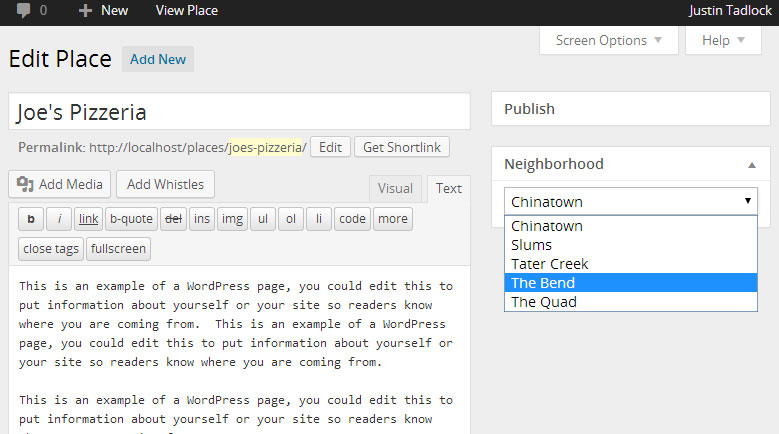Post relationships: Parent-to-child
WordPress supports very little in the way of post relationships. The only one it supports out of the box is a one-to-one relationship from parent-to-child. One of the questions that I see once in a while is how to make a post from one post type a child of a post from another post type.
A user on my support forums at Theme Hybrid had an interesting project he was building. Here’s an extremely general outlook at his setup.
- “Neighborhood” custom post type.
- “Place” post type for individual places within a neighborhood.
- Both post types are flat (non-hierarchical).
- Each place needed to be assigned to a specific neighborhood.
Because this was an interesting project with such a simple solution, I thought I’d share it with everyone.
How to assign a parent post
I’m going to assume you’re advanced enough to know how to build a plugin as well as understand the inner-workings of post types. If not, I recommend reading my tutorial on post types for WordPress.
For this project, you’ll need two non-hierarchical post types named neighborhood and place. Now, for the fun part. All you need to do is add the following code to your plugin’s admin files.
/* Hook meta box to just the 'place' post type. */
add_action( 'add_meta_boxes_place', 'my_add_meta_boxes' );
/* Creates the meta box. */
function my_add_meta_boxes( $post ) {
add_meta_box(
'my-place-parent',
__( 'Neighborhood', 'example-textdomain' ),
'my_place_parent_meta_box',
$post->post_type,
'side',
'core'
);
}
/* Displays the meta box. */
function my_place_parent_meta_box( $post ) {
$parents = get_posts(
array(
'post_type' => 'neighborhood',
'orderby' => 'title',
'order' => 'ASC',
'numberposts' => -1
)
);
if ( !empty( $parents ) ) {
echo '<select name="parent_id" class="widefat">'; // !Important! Don't change the 'parent_id' name attribute.
foreach ( $parents as $parent ) {
printf( '<option value="%s"%s>%s</option>', esc_attr( $parent->ID ), selected( $parent->ID, $post->post_parent, false ), esc_html( $parent->post_title ) );
}
echo '</select>';
}
}
That’s all there is to it. You will, of course, want to alter the post type names to reference your own post types.
Here’s a quick screenshot of the admin after applying the above code.

The hard part
So, the next question becomes, “How do I set up a hierarchical permalink structure for this?” I’d rather have hot pokers thrust into my eyeballs than try to explain the WordPress rewrite API. Ozh did a heck of a job writing that chapter in our Plugin Dev Book if you’re interested in diving into that sort of thing.
A lot of that depends on your custom setup anyway, so I’ll leave that tutorial for another day.
Other post relationships
Sure, this is cool, but it’s also limited. With your thinking cap on and post meta, you can do some pretty neat stuff outside of parent-to-child relationships. It’s not that tough for simple stuff, but for more complex relationships, you’ll need to look at other solutions.
Post relationships are potentially on the roadmap, but don’t count on that being available soon. Until then, I highly recommend the Posts 2 Posts plugin.